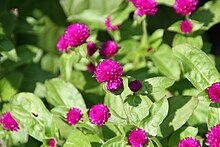| Gomphrena globosa | |
|---|---|

| |
| Purple-flowered form | |
| Scientific classification | |
| Kingdom: | Plantae |
| Clade: | Tracheophytes |
| Clade: | Angiosperms |
| Clade: | Eudicots |
| Order: | Caryophyllales |
| Family: | Amaranthaceae |
| Genus: | Gomphrena |
| Species: | G. globosa
|
| Binomial name | |
| Gomphrena globosa | |

Gomphrena globosa, commonly known as globe amaranth, is an edible plant from the family Amaranthaceae. The round-shaped flower inflorescences are a visually dominant feature and cultivars have been propagated to exhibit shades of magenta, purple, red, orange, white, pink, and lilac. Within the flowerheads, the true flowers are small and inconspicuous.[1]
Gomphrena globosa is native to Central America including regions Panama, and Guatemala, but is now grown globally.[2] As a tropical annual plant, G. globosa blooms continuously throughout summer and early fall. It is very heat tolerant and fairly drought resistant, but grows best in full sun and regular moisture.[3] The plant fixes carbon through the C4 pathway.[4] At maturity, the flowerheads are approximately 4 centimetres (1.6 in) long and the plant grows up to 24 inches (61 cm) in height.[1]
Gomphrena globosa is an outcrossing species that is pollinated by butterflies, bees, and other insects. Floral volatiles likely play a significant role in the reproductive success of the plant by promoting the attraction of pollinators.[1]
- ^ a b c Jiang, Yifan; Zhao, Nan; Wang, Fei; Chen, Feng (2011-01-01). "Emission and Regulation of Volatile Chemicals from Globe Amaranth Flowers". Journal of the American Society for Horticultural Science. 136 (1): 16–22. doi:10.21273/JASHS.136.1.16. ISSN 0003-1062.
- ^ Roriz, Custódio Lobo; Barros, Lillian; Carvalho, Ana Maria; Santos-Buelga, Celestino; Ferreira, Isabel C.F.R. (2014). "Pterospartum tridentatum, Gomphrena globosa and Cymbopogon citratus: A phytochemical study focused on antioxidant compounds" (PDF). Food Research International. 62: 684–693. doi:10.1016/j.foodres.2014.04.036. hdl:10198/10145.
- ^ Silva, Luís R.; Valentão, Patrícia; Faria, Joana; Ferreres, Federico; Sousa, Carla; Gil-Izquierdo, Angel; Pinho, Brígida R.; Andrade, Paula B. (2012). "Phytochemical investigations and biological potential screening with cellular and non-cellular models of globe amaranth (Gomphrena globosaL.) inflorescences". Food Chemistry. 135 (2): 756–763. doi:10.1016/j.foodchem.2012.05.015. PMID 22868155.
- ^ Herold, A.; Lewis, D. H.; Walker, D. A. (1976-05-01). "Sequestration of Cytoplasmic Orthophosphate by Mannose and Its Differential Effect on Photosynthetic Starch Synthesis in C3 and C4 Species". New Phytologist. 76 (3): 397–407. doi:10.1111/j.1469-8137.1976.tb01475.x. ISSN 1469-8137.